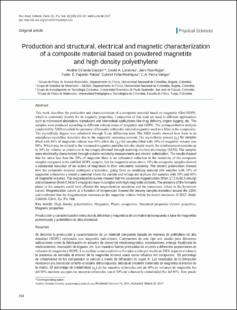Production and structural, electrical and magnetic characterization of a composite material based on powdered magnetite and high density polyethylene
...
Garzón, Andrés | 2017-06-30
This work describes the production and characterization of a composite material based on magnetite filled HDPE,
which is commonly known for its magnetic properties. Composites of this kind are used in different applications
such as microwave absorption, transducers and biomedical applications like drug delivery, organs tagging, etc. The
samples were produced according to different volume ratios of magnetite and HDPE. The semiquantitative analysis
conducted by XRD revealed the presence of hematite within the mineral magnetite used as a filler in the composites.
The crystallinity degree was calculated through X-ray diffraction tests. The XRD results showed how there is an
amorphous-crystalline transition due to the magnetite increasing content. The crystallinity percent (χc
) for samples
filled with 40% of magnetite volume was 90% while the (χc
) for samples filled with 10% of magnetite volume was
80%. Which may be related to the increased magnetite particles into the plastic matrix for reinforcement contents up
to 30% by volume, as evidenced in the images obtained through scanning electron microscopy (SEM). The samples
were electrically characterized through volume resistivity measurements and electric polarization. The results showed
that for ratios less than the 20% of magnetite there is no substantial reduction in the resistivity of the composite
samples compared to the unfilled HDPE samples, but for magnetite ratios above 30% the composite samples showed
a substantial reduction of six orders of magnitude in their volumetric resistivity. The electric polarization showed
how the composite material undergoes a transition, going from an insulating material (for samples with 10% of
magnetite volume) to a resistive material where the current and voltage are in phase (for samples with 30% and 40%
of magnetite volume). The magnetization curves showed that the saturation magnetization (from 17,3 to 60,5 emu/g)
and remanence (from 0,94 to 5 emu/g) increase in samples with high magnetite contents. The presence of the hematite
phase in the samples could have affected the magnetization saturation and the remanence values in the hysteresis
curves. Magnetization curves as a function of temperature showed the Verwey samples transition around the 120K
and confirmed that the magnetization increases as the magnetite volume within the matrix increases. © 2017. Acad.
Colomb. Cienc. Ex. Fis. Nat.
LEER










